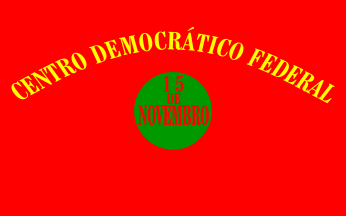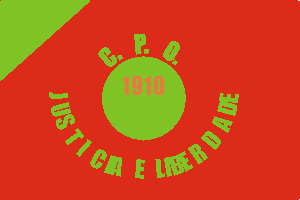
Last modified: 2005-08-26 by antonio martins
Keywords: disc (green) | centro democratico federal | 15 de novembro | c.p.o. | justiça e liberdade | 1910 | carboneria | carbonária |
Links: FOTW homepage |
search |
disclaimer and copyright |
write us |
mirrors
The republican revolution of 1910 (and previous attempts and
demonstrations) was largely inspired by a radical republican secret society
called Carbonária (akin to the Masonry), inspired in an
older italian organization of the same name. These called themselves the
charcoal-makers (carbonari), who were free to go out of town to the
forests get their wood… and conspire at will away from the
landlord’s spys — hence the alias The Forest Masons
(Maçonaria Florestal). Being Saint John the patron of
charcoal-makers, red and green was also theier
color, both of genuine
charcoal-makers guild and of the later secret society, and later the
color of portuguese radical republicans…
António Martins, 19 Feb 1998
I didn’t know the Carbonari existed
outside of Italy. The Carbonari flag was horizontal stripes of blue
(top), red and black, representing the burning charcoal.
Dave Martucci, 22 Feb 1998
Portuguese Carbonarians (namely Associação 31 de Janeiro,
in Oporto) used a red flag with a green circle and some lettering. I was
told these are based on (charcoal maker’s patron) St. John.
António Martins, 3 Mar 1998

The flag of the Centro Democrático Federal «15
de Novembro»; approx.
1:2 red field with green disc, on it "15 / DE / NOVEMBRO",
red, in three lines, and arched above, in larger green letters,
"CENTRO DEMOCRATICO FEDERAL" (no accent mark).
António Martins, 15 Mar 2000

Flag shown in the cover of the book La revolución portuguesa (The
Portuguese revolution), by J. Brissa, edited in Barcelona in 1910.
Santiago Dotor, 14 Mar 2000
I have no idea about the green triangle on this flag from Brissa’s
book. All other differences (wording and ratio) seem
to be variants of a popular design. "C.P.O." might mean "Centro Popular
Operário" (Worker’s People’s Center).
António Martins, 15 Mar 2000 and Dec 2001